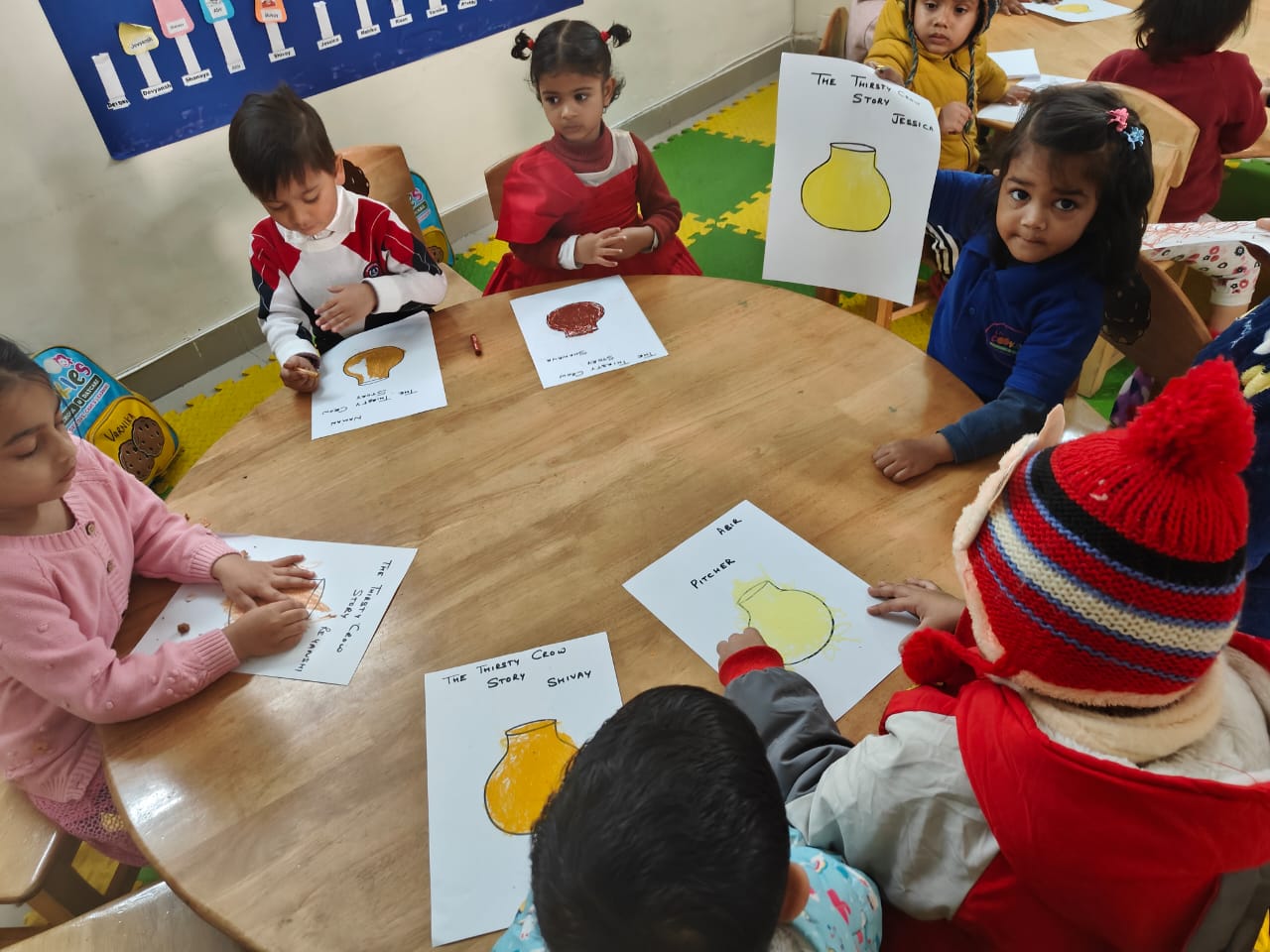12 Strategies for wholesome development of your child’s brain

In this blog we will try to summarise the book "The Whole-Brain Child" by Daniel J. Siegel and Tina Payne Bryson. It is a parenting book that provides insightful and practical strategies to help parents nurture and develop their child's brain, foster emotional intelligence, and promote overall well-being.
The book emphasises the importance of understanding children's developing brain and provides revolutionary strategies to support this development. It introduces the concept of integration, which involves connecting the various parts and functions of the brain.
The authors also discuss the importance of using everyday interactions to help children develop and provide practical ways to implement the strategies.
The book is praised for its practical wisdom and actionable ideas, making it valuable for parents, grandparents, teachers, or therapists. It also offers guidance on how to integrate the different parts of a child's brain and create a nurturing environment for their overall development.
Key Concepts
The central concept underlying the book’s strategies is integration. It involves connecting different parts and functions of the brain to achieve overall well-being. By fostering integration, parents can help their children thrive emotionally, socially, and intellectually. The author underlines different types of integrations which includes integrating the upstairs and downstairs brain, memory integration, integrating the different parts of self, and integrating self and other. It also provides strategies for parents to apply these concepts in their interactions with children.
Two brains are better than one: Integrating left and right brains
Physiologically Human brain is divided into two hemispheres. Your left brain craves order. It operates logically, literally, and linguistically—favouring words and linear sequences. It delights in the alliteration of “L” words and thrives on lists.
In contrast, your right brain is holistic and nonverbal. It communicates through facial expressions, eye contact, tone of voice, posture, and gestures. Rather than fixating on details and order, the right brain focuses on the broader picture—the emotional essence and personal memories associated with experiences.
Strategy 1
The best strategy is to use The “connect and redirect” method. It involves two steps: first, connecting with the child’s right brain by responding to their emotional needs, and second, redirecting their attention to the left brain by using logic and reasoning.
When a child is upset, logic often won’t work until the child's feelings are understood and validated by the parent. This is why the parent needs to attune to the child’s right brain first, using nonverbal signals and empathetic words.
By connecting with the right brain, the parent can help the child calm down and become more receptive to the left brain’s problem-solving skills. This is how the parent can redirect the child’s attention to the situation at hand and help them find a solution.
Strategy 2
Second Strategy involves utilising The “Story-telling” method.Storytelling is a powerful tool for distracting and calming children, there’s science behind its effectiveness. Our right brain processes emotions and autobiographical memories, while the left brain makes sense of these feelings.
Retelling the story of a difficult or scary experience helps children integrate their left and right brain, which allows them to make sense of what happened and calm their emotions.
Parents can help their children retell the story by asking open-ended questions, filling in the details, and validating their feelings.
Healing from difficult experiences occurs when the left brain collaborates with the right brain to tell our life stories.
Children benefit from using their left brain to organise and name their strong emotions, allowing them to respond healthily to various situations. Parents are advised to augment this activity with journaling, so that children can evolve emotional circuitry and better name emotions.(Name it to tame it)
“Teach your kids about two sides of Brain”. The author suggests that parents can improve their own integration by becoming more aware of their own brain states and tendencies, and by using both sides of their brain in a balanced way.
Building the staircase for the brain : Integrating the Upstairs and Downstairs of the brain
Imagine the brain as a two-story house. The downstairs brain develops early and is responsible for basic bodily functions (like breathing) and strong emotional reactions (such as anger, fear, and freeze responses).
While Upstairs is where intricate mental processes occur, including thinking, imagining, and planning. It involves sound decision making, planning, and analytical thinking. It’s responsible for several desirable traits: emotional regulation, self-understanding, empathy, and morality.
Optimal brain function occurs when the upstairs and downstairs brain work in harmony. As parents, our goal is to construct and reinforce a metaphorical stairway connecting the child’s upper and lower brain. When this staircase is fully functional, the upper and lower brain regions become vertically integrated.
Strategy 3
Third strategy which is for building staircase can be “Engage and Not Enrage: Appealing to upper brain”
Whenever we say, “Convince me” or “Find a solution that works for both of us,” we provide our kids with an opportunity to practise problem-solving and decision-making.
We can guide them in considering appropriate behaviours, consequences, and empathising with others. All of this happens because we’ve learned to engage the upstairs brain rather than triggering the downstairs reactions.
Strategy 4
Fourth Strategy is to “Use It or Lose It: Exercising the Upstairs Brain” Throughout your day, pay attention to opportunities for your children to engage different functions of their upstairs brain. And explore their key functions. :
Sound Decision Making:
As parents, we often want to make decisions for our kids to ensure they consistently do the right thing.
However, it’s crucial to provide them with practice in making decisions for themselves.
Even simple choices, like asking a young child, “Do you want to wear your blue shoes or white shoes today?” contribute to strengthening the upstairs brain.As kids grow older, gradually give them more responsibility in decision making.
For challenging dilemmas, such as conflicting commitments involve them in the decision-making process.
Allowances also offer an excellent opportunity for older kids to grapple with difficult choices (e.g., buying a computer game now versus saving for a new bike).
The key is to let children wrestle with decisions and experience the consequences.Remember, the goal isn’t perfection in every decision right now; it’s about nurturing an optimally developed upstairs brain for the long term.
Controlling emotions and the body
Helping children control their emotions and physical reactions is essential. We can teach them about techniques like deep breathing, counting to ten, expressing feelings, and physical outlets (like stomping feet or punching a pillow).
By understanding what happens in their brains during emotional moments, kids can learn to avoid “flipping their lid.” Even young children can choose to stop and think instead of reacting impulsively.
While they won’t always make perfect decisions, practising alternatives other than lashing out strengthens their upstairs brain over time.
Self- Understanding
Self understanding is about how parents can help their children develop self-understanding by asking them questions that make them think beyond the surface level. For example, a father who asked his daughter about her feelings and expectations for going to camp.
It also involves activities such as journal writing, drawing, and storytelling, to enhance children’s self-awareness. By reflecting on their internal experiences, children can better understand and respond to their inner and outer worlds.
Empathy
Empathy is required for a meaningful life. Parents can help their children develop empathy by asking them questions that make them think about other people’s feelings. Prompt questions in different situations can be like, at a restaurant, while reading, or leaving a store.
By exposing children to other people’s emotions, parents can foster their compassion and exercise their upstairs brain. Scientifically speaking that empathy may be related to a complex system of mirror neurons which cannot be completely explained here.
Morality
Parents can help their children develop a strong sense of morality by fostering their upstairs brain functions. When children can make sound decisions, control themselves, and empathize with others, they will have a moral compass that goes beyond their own needs.
It can be practied by activities such as asking questions about morals and ethics, presenting hypothetical scenarios, and modeling moral behavior. It claims that by doing so, parents can help their children build a solid foundation for their future decision making and upstairs brain development.
Strategy 5
Fifth Strategy is to Move It or Lose It: Moving the Body to Avoid Losing the Mind. The body is full of information that it sends to the brain. In fact, a lot of the emotion we feel actually begins in the body.
Our churning stomach and tense shoulders send physical messages of anxiety to the brain before we even consciously realize that we’re nervous. The flow of energy and information from the body up into our brain stem, into our limbic region, and then up into the cortex, changes our bodily states, our emotional states, and our thoughts.
When your kids are upset or out of control, try to make them move. For little ones, you can try some fun, creative activities, like biking, camping etc.
Kill the Butterflies! Integrating Memory for Growth and Healing
In our everyday life, we use two types of memory that work together. Implicit memory is when we do something without realizing we are remembering it. For example, changing a baby’s diaper without thinking about how to do it. Explicit memory is when we remember a specific past event on purpose. For example, remembering the first time we changed a diaper.
When we talk about memory, we usually mean explicit memory: a conscious memory of something that happened. But both types of memory are important for us and our children. By understanding these two types of memory, we can help our kids with what they need as they grow up and face challenges.
In order to integrate implicit and explicit memory author advises these strategies
Strategy 6
Sixth strategy is to Use the Remote of the Mind: Replaying Memories. There’s a part of our brain whose very job is to do just that: to integrate our implicit and explicit memories, so that we can more fully understand the world and ourselves. It’s called the hippocampus, and it can be considered the “search engine” of memory retrieval.
The hippocampus works with different parts of our brain to take all of the images, emotions, and sensations of implicit memory and draw them together so that they can become the assembled “pictures” that make up our explicit understanding of our past experiences.
The strategy involves how parents can help their children cope with painful memories by using the analogy of an internal DVD player. This is a mental tool that allows children to replay, pause, rewind, and fast-forward their memories. This way, they can have some control over how they remember their experiences.
Strategy 7
Seventh Strategy is Remember to Remember: Making Recollection a Part of Your Family’s Daily Life
To help your child think more deeply about specific events, you can look at photos and videos with them. Another great way to help them focus is to create a “memory book” with your child.
For instance, when your daughter comes back from her first camp, you can gather the letters she wrote, the souvenirs she collected, and the pictures she took, and make a memory book with her. She can add little stories and comments on the sides: “This was where I slept,” or “This was after the foam fight.”
Making a book like this helps your daughter remember some of the details she might forget later, and also lets her share more with you about this important experience in her life. By asking questions and stimulating memory you help them better understand what’s going on with them in the present.
It is advisable for the parents to begin by integrating your explicit and implicit memories. By combining your implicit and explicit memories and being aware of your past challenges, you can understand how your past influences your relationship with your children. You can be alert to how your problems affect your mood and your kids’ feelings. When you feel inadequate, annoyed, or too emotional, you can examine the causes of those feelings and see if they are related to something in your past.
Strategy 8
Eighths strategy is Let the Clouds of Emotions Roll By: Teaching That Feelings Come and Go
Parents must teach their children that feelings are temporary and changeable, like the weather. Children need to understand that their emotions will pass. They won’t always feel sad, angry, hurt, or lonely. This is surely a hard concept for kids to grasp at first, and they need help from adults.
Most feelings last only ninety seconds, and if children can realise that, they can develop mindsight, which is the ability to see their feelings clearly and not let them kneel. It gives an example of a boy who said, “I’m not dumb; I just feel dumb right now.”
Strategy 9
Nineth strategy is SIFT: Paying Attention to What’s Going On Inside
Parents can help their children develop mindsight, which is the ability to influence their thoughts, desires, and emotions. Children need to be aware of what they are experiencing and recognize the different aspects of their wheel of awareness.
You may get your kid on the rim using SIFT technique. They can be taught to SIFT their sensations, images, feelings, and thoughts. Intent is to make them more aware of their body sensations and what they mean, such as anxiety, anger, sadness, etc.
It also says that children can learn to relax their body and calm their emotions by breathing deeply. It claims that by recognizing different sensations, children can gain more understanding and control over their feelings.
The Me-We Connection Integrating Self and Other
It requires that parents should not expect their children to be perfect, but rather trust the process and guide them toward becoming mature and empathetic adults. Some people have less neural connections for empathy and relationships, and they need to practice and strengthen those connections in their brain.
This is a developmental issue, not a character flaw. It must be noted even children who are not naturally inclined to connect and care can learn how to be in a relationship and fulfil their duties.
Trick is to help them develop mindsight (Insight + Empathy = Mindsight) , which is the ability to see their own mind and the mind of others. Children need to develop a strong sense of “me” and a sense of “we” to be integrated with others. It says that this is important for their adaptation in a changing world.
Strategy 10
Tenth strategy is to Exercise Mindsight: Getting Back to the Hub.
With the help of their parents, children can develop mindsight and focused attention, which are skills that help them integrate their sensations, images, feelings, and thoughts. It explains that children need to learn how to shift their focus from the rim to the hub of their wheel of awareness, so they can have more control over their experiences.
It suggests that parents can teach their children tools and strategies to calm themselves and integrate their feelings and desires, such as mindsight exercises. It claims that by helping children return to the hub of their wheel, parents can help them become more focused, centred, and aware of their emotions and state of mind.
Strategy 11
Increase the Family Fun Factory: Making a Point to Enjoy Each Other
This strategy is about how parents can balance discipline and fun with their children. It explains that parents often feel too busy to discipline and forget to enjoy being with their kids. Author suggests that parents adopt a “playful parenting” approach, which helps children develop relationships and connect with others.
He says that playful parenting involves having positive and fun experiences with the kids, while still maintaining rules and limits. By doing so, parents can help their children value relationships and have more positive and healthy relational experiences in the future.
Strategy 12
Connection Through Conflict: Teach Kids to Argue with a “We” in Mind
You have been teaching your child how to get along with others since she was a baby—how to understand how they feel, how to communicate with them, how to share, how to say sorry. These are the same skills you need to keep teaching her as she grows up.
Talk about these skills often, and practice them. Whether you’re helping your child empathize with someone else, or write a sorry note, teach her that conflict is not something to run away from but to solve, and that this can make a relationship better.
So this was an executive summary for the book "The Whole-Brain Child" by Daniel J. Siegel and Tina Payne Bryson. The book gives many practical examples to implement these strategies in real life. You will also gain the nuances of brain functioning and how to mould it at the initial stages of brain development. We highly recommend you to go through this book once.


Comments
Renu bisht February 17, 2024 at 02:37 PM
Welcome to the realm of Blog Commenting Sites – a dynamic space where ideas, opinions, and conversations flourish. In the ever-expanding digital landscape, blogs have become a pivotal platform for individuals, businesses, and enthusiasts to share their thoughts and expertise. However, a blog’s true
kapil dev February 17, 2024 at 12:46 PM
hello